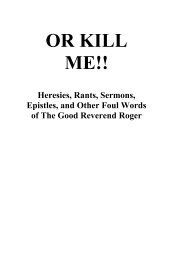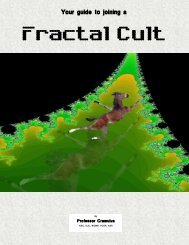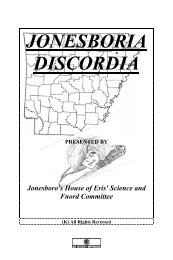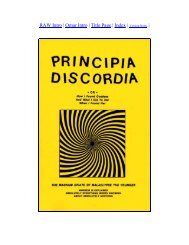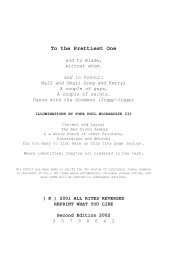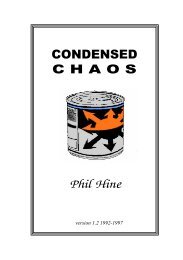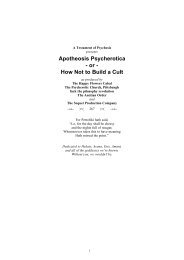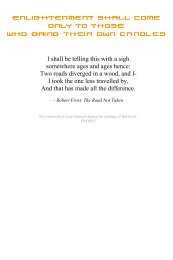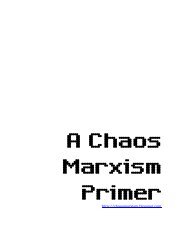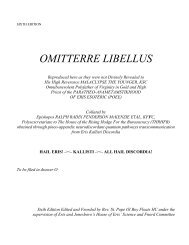Coincidance - Principia Discordia
Coincidance - Principia Discordia
Coincidance - Principia Discordia
Create successful ePaper yourself
Turn your PDF publications into a flip-book with our unique Google optimized e-Paper software.
COINCIDANCE 165<br />
mathematical mind that such a symbolism could be mechanically reproduced<br />
and we would then have something akin to a "thinking machine." It is<br />
amusing that those who think computers think (or will soon think)<br />
generally consider themselves materialists, while those who claim I Ching<br />
thinks call themselves mystics, but if thought is defined in these terms, then<br />
both computers and 1 Ching must be considered to be thinking. (The fact that<br />
the human nervous system operates on a similar binary code may account<br />
for our occasional impression that humans also think, at least outside the<br />
areas of politics and religion.)<br />
The implied thesis of these notes is that Joyce, Leibniz and the authors of I<br />
Ching all found this system independently and in different ways because it<br />
does, in fact, exist on the level of the non-local "mind" or system ( )<br />
underlying all individual minds or Egos ( }. This is the I AM or A Ham<br />
which appears in Gaelic, Hebrew, Sanskrit and about 60 other languages<br />
throughout the pages of FW: Plutarch's explanation of the E at Delphi,<br />
There is one feature of I Ching which appears in Joyce but not in<br />
binary—the moving lines ( and ) which transform active yang to<br />
passive, active yin to passive, or vice versa. These are, of course, Joyce's<br />
non-aristotelian functions as hidden unity behind and , and as<br />
hidden unity behind and . I am happy to say that the Taoist<br />
philosopher and Tai Chi master, Chiang Ling Al Huang, agreed with me<br />
about this point when I presented these isomorphs at Esalen Institute in<br />
March 1986.<br />
It is amusing (or bemusing) to note that binary and I Ching are not only<br />
isomorphic to FW but also, as Martin Schoenberger has noted, to the genetic<br />
code. The full details are explained in Dr. Schoenberger's The I Ching and the<br />
Genetic Code; for our purposes here it is enough to note the following:<br />
The DNA is made up of two opposite spirals, positive and negative, which<br />
can easily be considered isomorphic to I Ching's yin (—) and yang (—), or<br />
Leibniz's 0 and 1, or Joyce's and These are bonded by four amino<br />
acids—adenine, guaine, cytosine and thymine, which are usually abbreviated<br />
A, G, C, T. If one dares to consider these isomorphic with active yang . ),<br />
passive yang I, active yin ) and passive yin ( , or Leibniz's 01,11,10<br />
and 00, or Joyce's and , then the parallel becomes staggering. In<br />
forming RNA messages—the genetic code—the T (thymine) drops out to<br />
be replaced by U (uracil) but we still have four elements—A, G, C, U—and if<br />
we permutate them by the now-familiar rule, making all possible combinations<br />
of three out of these basic four "letters," we get again 4 3 or 64 "words,"<br />
which are the 64 elements of the genetic language.<br />
But if the genetic language has two foursomes—the A,C,G,T that bond<br />
the DNA. and the A, C, G, U that unwind from this and make the 64



